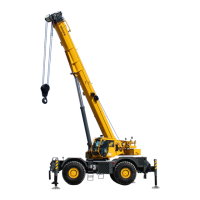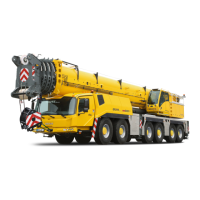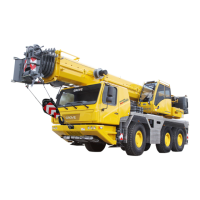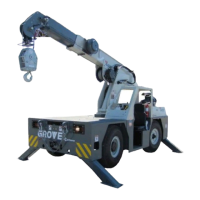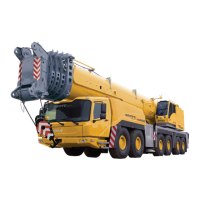UNDERCARRIAGE TMS700E SERVICE MANUAL
8-62 Published 01-29-2015, Control # 512-01
OUTRIGGERS
Description
The outriggers, when properly extended and set, provide a
rigid four point platform which is capable of supporting the
crane and its maximum load capacity. The outriggers consist
of inverted jack cylinders with outrigger beams to allow for
fully retracted, partial extension, and fully extended
operation. A center front jack is provided for stabilization.
The outriggers are fully hydraulic. The front outrigger box is
mounted behind the front axles while the rear outrigger box
is mounted behind the rear axles. The front jack is mounted
on the center of a crossmember at the front of the crane.
The beam assembly (see Figure 8-65) contains the 6.4 cm
(2.5 in) bore extension cylinder and the 11.4 cm (4.5 in) jack
cylinder which is mounted in a tube at the end of the beam.
The outrigger circuit consists of an integrated outrigger
selector valve, two outrigger manifold valves, four extension
cylinders, five jack cylinders, a relief valve, a pressure
switch, (pilot operated) check valves and four Outrigger
Monitoring System (OMS) (Optional—Standard in North
America) string potentiometers. The two front extension
cylinders are mounted in the front outrigger beams and the
two rear extension cylinders are mounted in the rear
outrigger beams. The front and rear jack cylinders are
mounted on their respective outrigger boxes; in turn the
outrigger boxes are mounted on the end of each outrigger
beam. The center front jack is mounted to the frame behind
the front bumper. Each jack cylinder has a port block
mounted on its side with the pilot operated check valve
threaded into the port block. The pressure switch is mounted
in a port on the center front jack cylinder. An OMS string
potentiometer (if equipped) is mounted inside each outrigger
box. The potentiometer is connected by a cable to the
outrigger beam to monitor the beam’s position—fully
retracted, mid-extend, or full extended.
There are three outrigger control panels on the crane. One
outrigger control panel is located in the superstructure cab at
the front left corner of the cab. There is also an optional
control panel on either side of the crane near the front
outriggers. When using either of these control panels, the
engine speed will be increased above idle when the
outrigger Extend/Retract Switch is moved to either position.
A sight bubble level is mounted on the right side console in
the cab and in each of the side control panels. The sight
bubble level provides the operator with a visual indication of
crane level attitude.
Theory of Operation
When the outrigger cylinder is activated, it extends or re-
tracts the outrigger beam within the outrigger box. The jack
cylinder is mounted to the end of the beam. The jack cylinder
applies force to the outrigger beam vertically. This sequence
of events provides for lifting and stabilizing the crane for
operation.
The appropriate Extension/Jack Switch must be depressed
before the outrigger Extend/Retract Switch is depressed.
Depressing one of the outrigger selector switches causes
that solenoid valve to open. As the outrigger Extend/Retract
Switch is moved, the integrated outrigger valve spool shifts
allowing flow to either the extend or retract line as applicable.
If the switch is in the EXTEND position, the flow continues
through the open solenoid valve to the piston side of the
cylinder. If the jack is to be extended, the flow first unseats
the cylinder check valve then extends the cylinder. The oil
from the rod end flows through the integrated outrigger
valve, and then to the reservoir.
When the outrigger switch is in the RETRACT position, the
flow through the selector valve is directed to the rod side of
the cylinder. The oil in the piston side flows through the open
solenoid back to the integrated outrigger valve. If a jack
cylinder is to be retracted, then pilot pressure from the
pressurized retract line unseats the cylinder check valve
allowing oil to flow from the piston side through the open
solenoid valve to the integrated outrigger valve. The
integrated outrigger valve directs the flow to the reservoir.
The integrated outrigger valve contains three relief valves.
The main relief is set at 172.40 bar (2500 psi) to protect the
system. Thermal protection is provided on the extend side by
a 241.30 bar (3500 psi) relief valve and the retract side by a
20.70 bar (300 psi) relief valve.
The front jack functions similar to any of the other outrigger
cylinders. The front jack will retract when the outrigger
Extend/Retract Switch is positioned to the RETRACT
position. After operating the main outrigger control, the
center front jack must be reset before operating the crane. A
pressure switch is used to sense pressure in the barrel end
of the cylinder after extension. When the pressure reaches
310.30 ± 1.38 bar (4500 ± 20 psi), the switch causes the red
Front Jack Overloaded Indicator to be illuminated on the
superstructure front console. This alerts the operator that the
center jack circuit senses over pressurization indicating an
overload condition. The inline relief valve prevents over
pressurization of the center front jack cylinder. The valve is
installed in line between the solenoid valve and the cylinder,
and is set at 13.80 bar (200 psi).
Reference Only
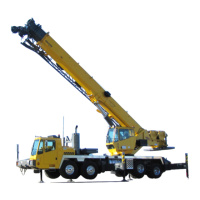
